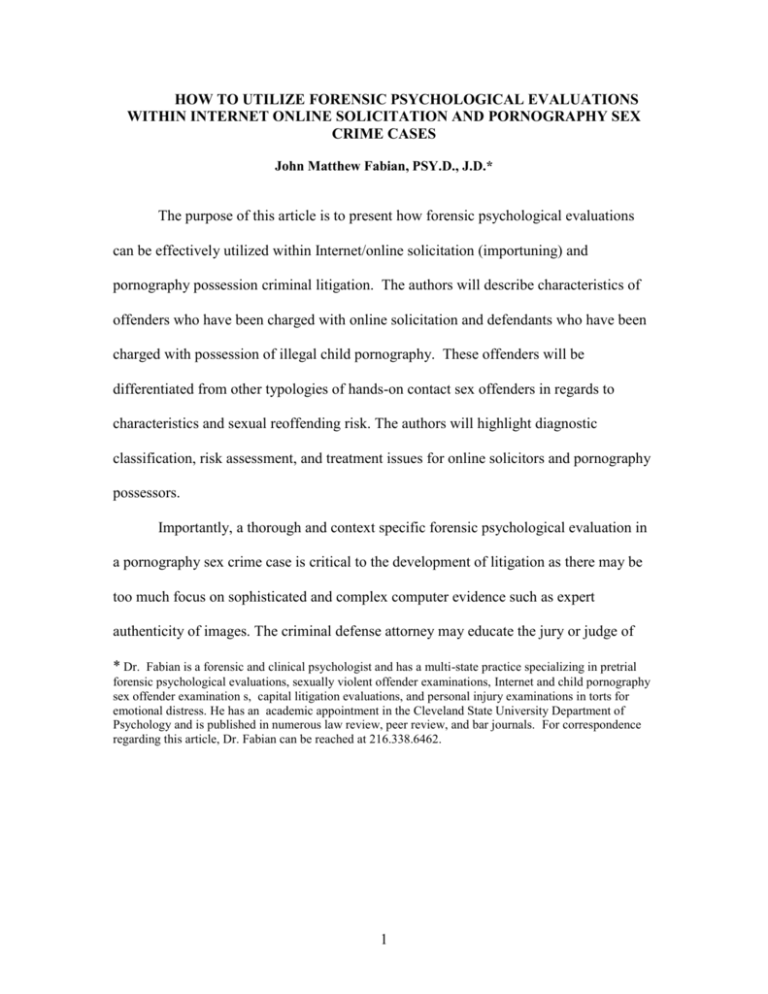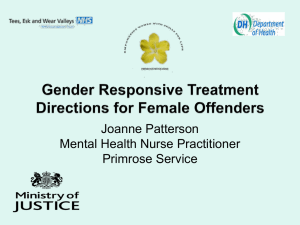
HOW TO UTILIZE FORENSIC PSYCHOLOGICAL EVALUATIONS
WITHIN INTERNET ONLINE SOLICITATION AND PORNOGRAPHY SEX
CRIME CASES
John Matthew Fabian, PSY.D., J.D.*
The purpose of this article is to present how forensic psychological evaluations
can be effectively utilized within Internet/online solicitation (importuning) and
pornography possession criminal litigation. The authors will describe characteristics of
offenders who have been charged with online solicitation and defendants who have been
charged with possession of illegal child pornography. These offenders will be
differentiated from other typologies of hands-on contact sex offenders in regards to
characteristics and sexual reoffending risk. The authors will highlight diagnostic
classification, risk assessment, and treatment issues for online solicitors and pornography
possessors.
Importantly, a thorough and context specific forensic psychological evaluation in
a pornography sex crime case is critical to the development of litigation as there may be
too much focus on sophisticated and complex computer evidence such as expert
authenticity of images. The criminal defense attorney may educate the jury or judge of
* Dr. Fabian is a forensic and clinical psychologist and has a multi-state practice specializing in pretrial
forensic psychological evaluations, sexually violent offender examinations, Internet and child pornography
sex offender examination s, capital litigation evaluations, and personal injury examinations in torts for
emotional distress. He has an academic appointment in the Cleveland State University Department of
Psychology and is published in numerous law review, peer review, and bar journals. For correspondence
regarding this article, Dr. Fabian can be reached at 216.338.6462.
1
their client’s potential low risk of sexual recidivism, amenability to treatment, and the
causes of the illegal behavior that might have their roots in psychiatric impairments that
are responsive to intervention.
TO CATCH A PREDATOR
Recently there has been initiation of widespread sex offender legislation
throughout the United States gearing towards harsher penalties, longer mandatory
minimum sentences for sex crimes, lifetime supervision of sex offenders by global
positioning satellite after they are released from prison, and indefinite civil commitment
of these offenders after their prison term expires. Such laws include the Adam Walsh
Child Protection and Safety Acti and the Jessica Lunsford Act.ii
These laws have been the topic of a media frenzy urged by television shows such
as Dateline’s “To Catch a Predator” and investigators Bill O’Reilly and Hannity and
Combs. While the statutes appear to aim towards protecting society from high risk sex
offenders, the public is led to believe that all sex offenders are dangerous “predators.” In
fact, the term “predator” is a misnomer because if that term is used, it should define an
offender who has a history of sexual crimes and who is likely to commit them in the
future. Many of these “On-Line” offenders are non-contact offenders, who either possess
pornography and/or are caught attempting to set up a meeting with an underage person.
These offenders are more likely than not to be low risk sex offenders who do not have a
history of sex offending.
NATURE OF LAW ENFORCEMENT INVESTIGATIONS
Each year, one in five youth encounter online solicitations that are sexual in
nature via chat-rooms or instant messaging routes. The National Juvenile Online
2
Victimization Survey has studied law enforcement investigations of Internet sex crimes
against minors. They have found that 25% of all arrests for Internet sex crimes against
minors were due to “proactive” investigations where police pose online as minors or
pretend to be mothers teaching their children about sex.iii These investigations allow law
enforcement to catch suspects before they have an opportunity to offend. Undercover
investigations can be referred to as “reactive” or “take over” when police learn of a
solicitation and they then pose as the original minor and target the suspect.
In the year 2000, one quarter (644) of the Internet sex crimes against juveniles
(about 2500 total arrests) were based on proactive investigation. Other arrests were for
crimes committed by the offenders who met the juveniles online (20%), other sex crimes
committed against juveniles by family members or acquaintances against juvenile victims
(19%), and the possession, distribution, or trading of pornography on the Internet (36% of
arrests).
TYPOLOGIES OF SEX OFFENDERS
Sex offenders are a heterogeneous group. There are several distinctions or classes
of sex offenders including but not limited to:
1) Rapists
2) Child Molesters
3) Hebephiles (sex offenders perpetrating post-pubescent females, 14-17 years of
age
4) Crossover sexual offenders- individuals whose victims are from multiple age,
gender, and relationship categories
5) Sex offenders who have engaged in hands on sex offending and pornography
possession
6) Non-contact sex offenders including voyeurs (peeping type offenders and
exhibitionists)
** 7) Non-contact pornography possession offenders and Internet solicitation
(Importuning) offenders.
3
For purposes of this article, we will focus on group 7, offenders who have been
charged with pornography possession and/or importuning type crimes (the latter
including offenders who solicit and attempt to meet an underage child from Internet
contact- either a real child or an undercover officer posing as a child). Not infrequently,
these importuning offenders also have possession of illegal pornography when
investigated by law enforcement. Ordinarily, these non-contact offenders are lower risk
offenders because they are older in age, well educated, married, have no history of sex
offenses (including hands-on sex offenses), lack diagnoses of paraphilias (sexual
deviancy), and are amenable to sex offender treatment.
DIAGNOSIS
In order to differentiate diagnostic possibilities, an attorney must seek the
assistance of an expert witness who has an extensive background evaluating sex
offenders within a forensic/legal context. A diagnosis is associated with the derivation
of sexual offending, risk assessment, and directions in treatment. Hands on sex
offenders, usually rapists and child molesters have unique characteristics. Often, rapists
possess antisocial personality disorder and have a history of both nonsexual and sexually
violent acts. Their criminal personality and sexual deviance elevate their risk level.iv
Child molesters (often qualifying for a diagnosis of pedophilia) have strong deviant
sexual desires towards children and commonly commit hands on sex offenses against
children under 13. They are more likely to possess pornography and utilize it in their
offending behaviors.
Pornography and importuning offenders are often a different ‘breed’ of sex
offender. These offenders often do not have a prior sex offense history. They rarely
4
possess an antisocial personality disorder and frequently do not qualify for pedophilia.
They may possess symptoms that fall under the rubric of the following categories:
1) Paraphilias (sexual deviancy disorders, i.e., pedophilia)
2) Hypersexual disorders
3) Obsessive compulsive disorders/Impulse Control Disorders
4) Online sexual problems/addictions
5) Other psychiatric disorders such as depression that include features of
emotional loneliness and isolation or stem from environmental issues such as
broken marriage and loss of employment. They may cope with these problems
through inappropriate sexual activity.
The most relevant paraphilic disorder concerning pornography offenders and
importuners would be pedophilia. One must experience recurrent, intense sexually
arousing fantasies, sexual urges, or behaviors involving sexual activity with a
prepubescent child or children, generally age 13 years or younger.
All too often, a defendant is contacted by a law enforcement officer who
imposters a 12 year old girl. The age of 12 is usually used to fulfill two purposes: to
establish an age relevant to pedophilia and also to satisfy harsher penalties under sex
offender laws. When considering this diagnosis, an expert should view all pornographic
images to consider the ages of the children/adolescents as many of these pictures will be
of teens older than age 13. The expert must determine if the individual was viewing
pornography for 6 months or longer. One can technically be diagnosed with pedophilia
by viewing child pornography (and not actually engaging in hands-on offending of
youth). Such use must cause them impairment in social, occupational, or other areas of
functioning.
5
Conversely, hypersexual disorders include a disturbance of more conventional
sexual functioning such as masturbating or the use of pornography and at some point the
use is compulsive and/or excessive and causes the person distress. Hypersexual disorders
may also include cybersex (Internet related activities geared for sexual arousal and
attracting others online).
Importantly for pornography and importuning sex offenders,
many of these individuals will teeter between sexual behavior that is socially acceptable
and not abnormal, and behavior that becomes pathological when the person suffers
distress or impairment in functioning.
Paraphilias and hypersexual disorders have also been considered to fall under the
psychiatric genre of obsessive-compulsive disorders and impulse control disorders.v The
obsession may be the intrusive thoughts about pornography and the compulsion may be
the repetitive masturbation to the images and the use of the computer. These behaviors
are hallmarked by their impulsive nature and likely represent addictions that are
motivated by intense drive states.vi
INTERNET ADDICTION & EMOTIONAL AVOIDANCE
Many offenders who have possessed pornography on their computers and
engaged in cyber-chat with underage females use the Internet to avoid negative emotional
states, such as depression, anxiety, anger, boredom, and loneliness.vii This is a critical
point because these offenders may not be sexually deviant, rather they use sex as an
outlet to deal with these emotional deficits.
The Internet serves as a device to access sexual material which ultimately assists
in relieving one’s sexual arousal and alleviating emotional distress and dissatisfaction in
one’s life. The Internet offers sex offenders an avenue to download pornography and
6
masturbate to images which is in effect a rewarding and reinforcing process leading to
further avoidance from dealing with one’s problems and human relationships.viii This
Internet behavior has an addictive quality with the subconscious process of avoiding
negative emotional states.
Internet addiction includes an individual who has obsessive thoughts about the
Internet and has volitional problems controlling Internet use leading to excessive amounts
of time online and failure to meet the demands of their everyday life. They will likely
experience negative emotional states when offline and increasing tolerance to the effects
of being online while denying problematic behaviors in their lives. When online, they
will have more positive feelings about themselves. This Internet addiction includes a
behavioral sequence that has a rewarding and reinforcing quality that mimics an impulse
control disorder such as Kleptomania. The images that stimulate sexual arousal, the
anonymity with the computer use including anonymous chat rooms and typing on the
computer, may play a role in making the Internet reinforcing.
An important feature, the anonymity of the computer use which includes having
relationships with others, is critical to many of these offenders, perhaps especially the
importuners. Importuning type offenders often lack relationships or are involved in
dissatisfied and conflictual relationships/marriages and the chat rooms allow an outlet to
have connections with others. This connection with others which may be legal (exposing
oneself through webcams to other consenting adults) may be reinforcing and have an
addictive quality. The adult male who searches for consenting women to view his ‘show’
may have a difficult time finding these women online. He may be afraid that the
individuals he is exposing himself to are in fact homosexual men posing as women. His
7
exposing activities which may not qualify for exhibitionism (because the viewers are not
‘unsuspecting strangers’) may be reinforcing to him when he does find viewers he deems
appropriate. However, given his emotional deficits and need for anonymous connection,
this type of offender is often vulnerable to an instant sex connection with an online law
enforcement agent who he thinks is an adolescent female.
Importantly, one may question the differentiation of the behavioral reinforcement
of the Internet use versus the function of the pornographic material itself.ix Both
resources serve the same purposes of obtaining reinforcing stimulation and avoiding
negative mood and emotional states. The Internet functions as an anonymous device to
access both connections with others via chat rooms as well as a resource to obtain
pornographic images to masturbate to. Each behavioral sequence on the Internet serves
as a motivation resulting in sexual arousal and orgasm which are pleasurable and
intrinsically rewarding.
Pornography offenders are unlike contact ‘hands on’ sex offenders as the access
to the Internet is available and immediate, controlled and anonymous. The predator who
society fears is the individual who stalks children and abducts them on playgrounds
eventually sexually assaulting them, often in a heinous fashion. Indeed, most
pornography offenders do not use pornography as a vehicle to stimulate themselves to
engage in a contact sex offense.
PROFILING THE ONLINE OFFENDER
A recent study by Mitchell, Wolak & Finkelhor (2005) investigated the
characteristics of offenders who were investigated during proactive police investigations
in which the suspects were soliciting youth online. The National Juvenile Online
8
Victimization Study has been a resource for the collection of data relevant to the number
and characteristics of arrests for Internet sex crimes against children. The authors found
that these offenders are almost always male, 61% between the ages of 26 and 39, 33%
were 40 years of age or older. Over 90% of the offenders were Caucasian who had
relatively stable incomes and were employed at the time of arrest. About 38% were high
school graduates and 44% had some college experience. About 60% of them lived either
in suburbs, rural areas, or small towns, and 34% were single and never married, 35%
were married, and 19% were divorced. Some of this data flies in the face of the data we
know about high risk sex offenders who often have a history of younger age, lower
education, unemployment, and single marital status.
About 13% of the offenders arrested in undercover operations had committed
crimes involving online identified victims. Those offenders who had online targets and
were part of an undercover investigation were more likely to be older, have higher
incomes, be employed full-time, and have lived with minors as parents or relatives at the
time of the their crimes than those offenders of juvenile victims. Online target offenders
had fewer prior arrests for non-sexual offenses and for sexual offenses against minors and
had engaged in less frequent sexually deviant behaviors than those offenders who
actually had juvenile victims they solicited online. Both groups had about the same rate
of child pornography possession (40%).
RISK ASSESSMENT
Risk assessment for the Internet solicitor and pornography possession non-contact
offender groups is a different ‘animal’ than that for the rapist or child molester (chronic
hands on offender groups). Some of the same risk factors apply to both groups, however,
9
the former group often has dynamic and changeable risk factors that are amenable to
intervention without the history of static and unchangeable factors that are immune to
treatment. Along the lines of static risk factors, the popular actuarial risk assessment
instruments such as the STATIC-99 are not appropriate to utilize with the hands-off sex
offenders as the normative samples the instrument’s data are based on are typically hands
on sex offenders (rapists and child molesters).
Importantly, pornography plays a minor role in the commission of most contact
sex offenders' offenses; however, when it is involved, it is usually utilized by sexually
deviant child molesters with extensive sex offending histories.x Critically, child
pornography offenders usually do not have a history of contact offending. Those with
prior criminal records for any type of offenses are significantly more likely to reoffend
criminally and sexually than those without a criminal record. Child pornography
offenders who have committed a prior or concurrent contact sexual offense are a higher
risk group to sexually recidivate.xi
TREATMENT & RISK MANAGEMENT ISSUES
Many pornography offenders have never volunteered for treatment and do not
have insight into the nature and severity of their problems until they are arrested in an
undercover sting operation causing them humiliation, divorce, separation from family,
and job loss. Pornography offenders and importuners are usually a treatable group.
Importantly, treating the sexual issues is only one piece of the puzzle. Many
offenders’ illegal acts are due to a variety of bio-psycho-social factors including
environmental stress such as marital relations, job dissatisfaction, emotional isolation,
10
lack of social support, anger/hostility issues, alcohol use, and poor coping skills. These
non-sexual elements need to be a focus of intervention.
Treatment should likely entail four modalities:
1) Group sex offender treatment (relapse prevention/cognitive behavioral modality)
2) Individual therapy to deal with issues such as depression, self-esteem, anger,
relationship instability, and divorce. Marital therapy should also be considered
3) Psychotropic medication, focusing on monoamine (norepinephrine, dopamine, and
serotonin) metabolism. Medication may include serotonin reuptake inhibitors which
modulate serotonin and decrease deviant sexual behavior, impulsivity, and
sexual appetite.
Lower risk sex offenders are more amenable to community supervision and treatment.
They will also display lower recidivism rates than the traditional high risk rapists and
child molesters.
KEY POINTS TO A SOLID FORENSIC PSYCHOLOGICAL EXAMINATION
1) The Forensic Psychologist Expert Must Attempt to View the Pornography and/or
Online Solicitation (Emails and Instant Messages)
Critically to these cases, the expert must attempt to view the pornography to
assess the stimuli that arouses the defendant. This again is important to establish sexual
deviance disorders and is relevant to risk assessment. This may be a problem as the
attorneys defending these cases nationally are struggling to obtain this data in discovery
due to the laws making it illegal for them and their expert witnesses to possess it as part
of their investigations. If allowed to review this data, the forensic psychologist expert
should foster a relationship with the computer forensic expert to become educated on
what kind and how much pornography the defendant was viewing. For example, the
expert witness should observe the log times and be aware of the amount of hard drive
pace on the computer because it reflects the storage capacity. The person may have stored
11
pornography on a USB hard drive, Thumb drive or Zip drive to increase storage capacity.
The Web Browser History, Cookies, and Temporary Internet Files should be accessed to
assess the defendant’s patterns of computer usage. Bookmarks such as the North
American Man-Boy Love Association (NAMBLA), the Lewis Carroll Collector’s Guild
or other similar sites advocating sex with minors may provide information to the expert
on the defendant’s interests. Chat room activity and emails should also be reviewed.
2) The Expert Should Be Aware of the Research Relevant to Pornography and it’s
Equivocal Association to Sexual Reoffending
There is little empirical evidence suggesting a direct causal link between
pornography viewing and sex offending. Pornography use can be neither a necessary nor
sufficient cause of sexual offending because sexual offenses are usually committed by
those offenders with little or no exposure to pornography.xii The role of pornography in
sexual offenses requires additional triggering factors as well as predispositional and
situational factors relevant to the onset of offending. In fact, sex offenders self-report
less frequent use of pornography then groups of non-sex offenders. Sex offenders also
are not prone to use offense related and non-conventional pornography than nonoffenders. Exposure to child pornography is likely an influential factor but not the sole
element in the development of sex offending. Notably, for preferential child molesters,
pornography aids pedophiles in satisfying and satiating their compulsive and persistent
sexual fantasies about children. Again, these offenders are a different typology than the
‘hands off’ pornography and importuning type offender.
12
3) The Expert Witness Must Have a History of Working with Various Types of Sex
Offenders and a Strong Knowledge Base Relevant to Risk Assessment
It is recommended that the attorney representing pornography possessing
offenders and importuners be aware of their client’s typology as a sex offender. This
class of offender is much different than the traditional contact sex offending rapist and
child molester. The representation of their client necessitates working within a
multidisciplinary team of experts. This process must be a cohesive one with various
experts relying on each other to not only authenticate the evidence but to understand the
mindset of the defendant, the etiology of his offending patterns, and the steps to
rehabilitation. The forensic psychologist must know when to and when not to apply
actuarial risk assessment instruments. Dynamic and changeable risk factors must be
intensely investigated and made a target for intervention.
4) The Expert and Attorney Must Intensely Question the Importuner About the
Details of His Online Solicitation and Motives Relevant to Meeting a Juvenile Victim
Most Online Solicitors do not have a history of hands-on sexual offenses. The
expert witness must analyze the defendant’s Internet communication with the online
targets and juvenile victims and compare this dialogue with any prior sex offense
behaviors.
CONCLUDING REMARKS
When considering a forensic psychological evaluation in Online solicitation and
pornography possession cases, the expert witness must attempt to view the pornography
and/or Online solicitation (emails and instant messages, etc.) The expert should establish
a relationship with the computer forensic expert and also encourage the attorney to make
motions to obtain access and viewing privileges of the pornography and similar
13
discovery. The expert should also be aware of the research relevant to pornography and
its equivocal association to sexual reoffending. The forensic mental health professional
must apply the individual characteristics of the defendant’s history and offending
behaviors to the empirical data relevant to diagnostic and risk assessment issues.
.
14
i
109 P.L. 248 (2006).
2006 Fl. ALS 25 (2006).
iii
K. Mitchell, J. Wolak, & D. Finkelhor. (2005). Police Posing as Juveniles Online to Catch Sex Offenders:
Is it Working? Sexual Abuse: A Journal of Research and Treatment, Vol. 17(3).
iv
Fabian, J. (2006). The Risky Business of Conducting Risk Assessments for Those Already Civilly
Committed as Sexually Violent Predators. William Mitchell Law Review, 32(1) 2005.
v
Krueger, R., & Kaplan, M. (2001). The Paraphilic and Hypersexual Disorders: An Overview. Journal of
Psychiatric Practice.
vi
Schwartz, M.F. & Southern, S. (2000). Compulsive cybersex: The new tea room. In A. Cooper (Ed.),
Cybersex: The dark side of the force (pp. 127-144.). New York: Taylor and Francis.
vii
Quayle, E., Vaughan, M., & Taylor, M. (2006). Sex offenders, Internet child abuse images and emotional
avoidance: The importance of values. Aggression and Violent Behavior (11).
viii
Greenfield, D., & Orzack, M. (2002). The Electronic Bedroom: Clinical Assessment of Online Sexual
Problems and Internet-Enabled Sexual Behavior. In A. Cooper (Ed.), Sex and the Internet: A Guidebook for
Clinicians (pp. 129-146).
ix
Quayle, E., & Taylor, M. (2002). Child pornography and the Internet: Perpetuating a cycle of abuse.
Deviant Behavior: An Interdisciplinary Journal, 23.
x
Carter, D., Prentky, R., Knight, R., Vanderveer, P., & Boucher, R. (1987). Use of Pornography in the
Criminal and Developmental Histories of Sexual Offenders. Journal of Interpersonal Violence, Vol. 2(2).
xi
Seto, M., & Eke, A. (2005). The Criminal Histories and Later Offending of Child Pornography
Offenders. Sexual Abuse: A Journal of Research and Treatment, Vol. 17 (2).
xii
Seto. M., Maric, A., & Barbaree, H. (2001). The role of pornography in the etiology of sexual
aggression. Aggression and Violent Behavior (6).
ii
15








